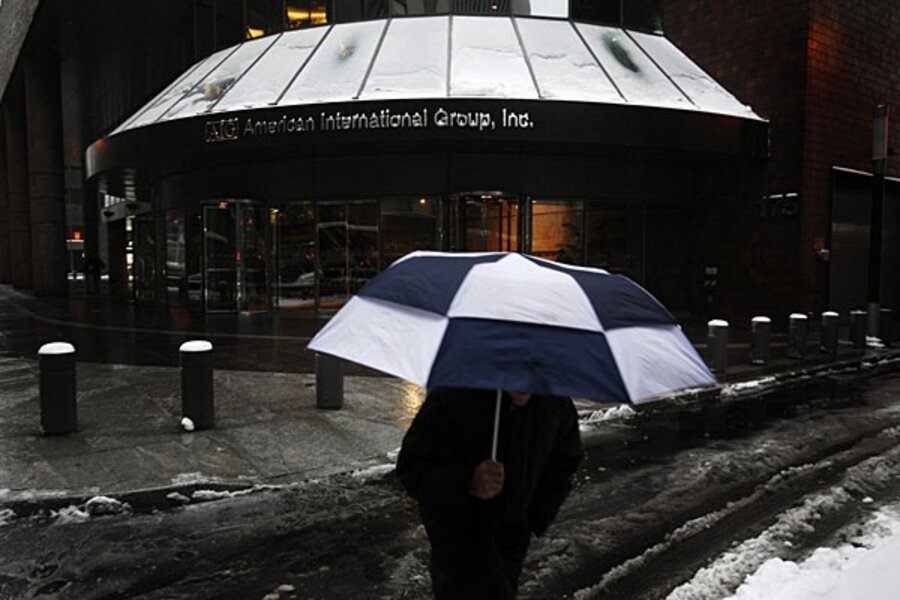Why US keeps backstopping a flattened AIG
Loading...
| New York
After Lehman Brothers failed in September, the financial markets froze up, causing interest rates to jump despite vigorous efforts by central bankers worldwide to keep credit flowing. Would the same thing happen – or perhaps something worse – if the US let troubled insurance giant AIG (American International Group) fail?
Yes, is the reply from the US Treasury and the Federal Reserve, which added another $30 billion commitment to AIG on Monday. This increases taxpayers’ pledges to the company to $180 billion – about the same amount to be spent this year under the just-passed economic stimulus package. It is the fourth time Uncle Sam has had to backstop the company.
“AIG by itself is not important, but it is intertwined in so many other aspects of our financial life and so many people rely on it in one form or another,” says Stan Collender, a partner at Qorvis Communications in Washington. “If AIG were allowed to go down, it could lead to possibly a global depression.”
AIG provides insurance to 100,000 entities, including small businesses, municipalities, 401(k) plans, and Fortune 500 companies, which employ more than 100 million Americans, notes a joint statement Monday from the US Treasury and the Federal Reserve about the complex financial transactions involving the company. In addition, AIG has 30 million policyholders and provides retirement insurance for hundreds of thousands of teachers and nonprofit organizations.
Unsettling to markets
The additional US financial commitment comes the same day that AIG reported a loss in the fourth quarter of $61.7 billion, the largest corporate loss ever in one quarter. Though the dismal news had been telegraphed late last week, investors drove up the value of the US dollar as they scrambled to buy US Treasury bills.
On Monday morning, the stock market reacted badly to the AIG loss and the turmoil in the financial markets. The Dow Jones Industrial Average quickly dropped below 7000.
“Seven thousand is a psychological level,” says Scott Brown, chief economist at Raymond James & Associates in St. Petersburg, Fla. “It’s all like a bad dream.”
The markets are unsettled in part because the government appears to be stumbling from one financial crisis to another, says Mr. Brown. “We need some kind of financial stability for a long-lasting recovery.”
For its part, AIG characterized the latest government effort as a restructuring that will strengthen its capital base and reduce the amount of money it owes taxpayers. The latest commitment by the US will allow AIG over a five-year period to raise $30 billion of capital by issuing noncumulative preferred stock to the US Treasury when the company needs the money.
At the same time, AIG said the government’s preferred-stock holdings will be modified so that they “more closely resemble common equity.” This is similar to what the US is doing with Citigroup.
“No one wants to inject capital in these companies if they see the government ahead of them” in terms of getting money back in the event of a bankruptcy, says Doug Roberts, chief investment strategist at Channel Capital Research.com in Shrewsbury, N.J. “Why take the risk?”
The move does increase the risk to taxpayers, however. “They no longer have a preferred position,” notes Mr. Roberts.
Despite its financial problems, AIG, in a statement issued Monday says its underlying businesses “remain strong, well-capitalized, and competitive.”
Since last September, the company has made progress in reducing “the excessive risk” from exposure to “certain financial products,” it says.
Peril of derivatives
AIG got into trouble after its London office sold enormous quantities of derivative-type financial products. These are complex financial instruments that are supposed to act like mortgages, commodities, or other financial products. According to news reports, AIG’s main clients were European banks.
When the US government made its first investment in AIG – some $85 billion – last September, the company planned to repay the taxpayers by selling some of its assets. However, now the company says the sharp decline in global economic conditions has adversely affected its ability to divest those assets.
“The very same global forces that we face have greatly diminished the ability of qualified buyers to raise the capital necessary to buy AIG’s businesses right now,” said Paula Rosput Reynolds, AIG’s vice chairman and head of restructuring.
That’s one reason AIG now will give the US equity stakes in two subsidiaries – Asia-based American International Assurance Co. and American Life Insurance Co. – in return for a reduction in $26 billion in debt it owes the government. The company also expects to transfer to the Federal Reserve Bank of New York securitization notes that are part of its insurance operations of up to $8.5 billion, a move that will also reduce the amount it owes the US.
The company’s executives say its insurance operations are fine.
“They’re secure, they are protected,” said Edward Liddy, the company’s CEO, in an interview Monday morning on the “Today” show. “It’s all the other ancillary businesses that are causing this. And it’s the decline in asset values around the globe.”
A disavowal of ‘public ownership’
In its joint statement, the US Treasury and the Fed said, “Public ownership of financial institutions is not a policy goal and, to the extent public ownership is an outcome of Treasury actions, as it has been with AIG, it will work to replace government resources with those from the private sector to create a more focused, restructured and viable economic entity as rapidly as possible.”
Roberts, the investment strategist at Channel Capital, is doubtful. Even with the latest AIG restructuring moves, the US government will still own about 80 percent of the ailing company.
“What it comes down to is you are effectively nationalizing the company,” Roberts says. “Then, why will anyone invest additional capital in AIG? So, the government is dancing around, saying there is still some value left for common shareholders.”





